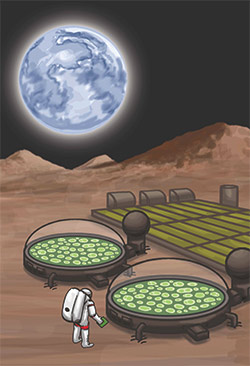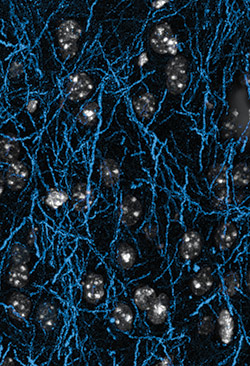The many frontiers of synthetic biology
From the astronomical …
Aerospace engineers working for NASA estimate that it will take 916 days for a manned spacecraft to get safely to Mars, complete a mission and then make the return trip, if launched from Earth with today’s technology. Most of the journey’s complexity stems from crew support. In order to decrease the load and propel a heavy, provision-laden craft across millions of miles, engineers are developing various Mars-based chemical and mechanical manufacturing techniques.

Synthetic biology, specifically genetically engineered microbes that can act like the matter-converting replicators in Star Trek, offers much promise. Using basic biological processes to create material goods would enable space missions to become self-sufficient and reduce the mass of equipment and supplies compared to proposed abiotic techniques. On a mission to Mars, biology-based space manufacturing can lower payload by 26 to 85 percent, according to recent research published jointly by Berkeley engineers and NASA researchers.
“One goal of our paper is to advocate for an expanded role for synthetic biology in space science, with a view toward future mission deployment,” says Amor Menezes, a postdoctoral researcher at QB3, the UCSF-based California Institute for Quantitative Biosciences. Menezes is the lead author of a recent Journal of the Royal Society Interface article that featured space-made biologically produced fuel, food, plastics and medicine. Adam Arkin, professor of bioengineering and division director of physical biosciences at Berkeley Lab, along with two scientists from NASA Ames Research Center, co-authored the paper.
The researchers identified microbes that can be engineered to convert gases from the Martian atmosphere or a spacecraft’s waste stream into useful supplies. A methane-oxygen fuel blend can be produced by harnessing Methanobacterium thermoautotrophicum, a single-celled organism common in sewage treatment plants and hot springs; cyanobacteria, such as Arthrospira or Synechocystis, can make spirulina food or the painkiller acetaminophen; and construction-grade biopolymers needed for 3-D printing replacement parts can be engineered from a soil bacteria, Cupriavidus necator.
“Space synthetic biology is truly groundbreaking. Abiotic technologies were developed for many, many decades before they were successfully utilized in space, and biological technologies like synthetic biology are only now seeing development efforts,” Menezes says. “So, of course these technologies have some catching-up to do when utilized in space. But it turns out that this catching-up may not be that much, and in some cases, the technologies may already be superior to their abiotic counterparts.”
… to the anatomical
Rather than gazing out across the heavens, bioengineering professor Sanjay Kumar has focused his attention inward. By engineering proteins inspired by the structural components of nerve cells, Kumar and a team of postdoc researchers are creating a smart coating that can be used in biological sensors, valves, drug delivery systems and medical diagnostic equipment.

“This work represents a unique convergence of the fields of biomimetic materials, biomolecular engineering and synthetic biology,” Kumar says. “We created a new class of smart, protein-based materials whose structural principles are inspired by networks found in living cells.”
Kumar and his team sought to create the biological equivalent of synthetic polymer brushes that are used in a variety of products, such as paint and cosmetics, to keep small particles from glomming together. They were inspired by neurofilaments, proteins that form the main structural networks within certain nerve cells.
The surfaces of individual neurofilaments are coated with protein “bristles” that act like polymer brushes. The bristles can form a stable network, which can prop open the nerve cell and allow electrical signal conduction.
Kumar’s team engineered a version of these bristles that could be bacterially synthesized in large quantities, purified and assembled with precise orientation on surfaces. The bristles expanded and collapsed dramatically if the salinity or acidity of the surrounding solution was changed, making them a sort of “smart” material. They are now actively exploring the properties and applications of the new biological materials. “We showed that our ‘protein brush’ had all of the key properties of synthetic brushes, plus a number of advantages,” Kumar says.

